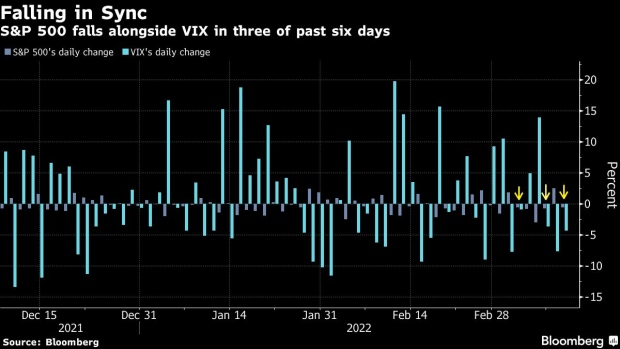Mar 10, 2022
Volatility Traders Becoming Less Impressed by Big Market Swoons
, Bloomberg News

(Bloomberg) -- What’s remarkable one day becomes commonplace when repeated often enough. It’s a sentiment settling into volatility markets with each lurch between euphoria and panic in the S&P 500.
Case in point is the Cboe Volatility Index, a thermometer for anxiety on Wall Street that normally jumps when the market tumbles. That pattern was absent Thursday, when despite the S&P 500 being down as much as 1.6%, the VIX spent most of the day either unmoved or in free fall. Concerted moves in the two gauges are rare, happening about one in five days.
Beyond traders getting used to one day’s tumble becoming the next day’s bounce, big shifts in institutional positioning could also be underpinning a sturdier foundation. Client data from JPMorgan Chase & Co.’s prime brokerage shows long-short hedge funds slashed risky positions for seven consecutive days, leading to the fastest “de-risking” in more than a year.
“We’re back to another point of people being well hedged and well positioned,” Amy Wu Silverman, an equity derivatives strategist at RBC Capital Markets, said by phone. “You’re also seeing people selling that volatility and doing some overwriting. That can probably dampen volatility.”
The defensive posture was evident in the trading volume of bearish versus bullish options. The 20-day average of the Cboe put-call ratio for equities hovered near a 22-month high, a sign of caution.
Despite Thursday’s retreat, the VIX has held above 30 for nine straight days, a stretch of elevation not seen since June 2020. Jarring reversals have been coming almost daily in 2022 as traders struggle to get a grip on the path of economic growth and fresh uncertainties around monetary policy following Russia’s invasion of Ukraine.
Designed to track options cost tied to the S&P 500, the VIX has historically tended to move in opposite directions with the equity index. In three of the past six sessions, however, the two slipped in sync. Tandem moves like this could reflect a lack of urgency to take up further hedging to guard against losses.
Read: Heavily Hedged Traders Have Been Awaiting a Stock-Market Storm
Professional speculators that make both bullish and bearish equity wagers have seen their notional equity exposure fall 25% from a one-year high, JPMorgan data show. While their levels of leverage have yet to match the troughs reached during the pandemic rout in March 2020, or the selloff in December 2018, the seven-day risk unwind approached the typical duration of degrossing during times of stress: eight to 12 days.
To JPMorgan analysts including John Schlegel, the furious unwinding suggested the market may have gone through the worst part of deleveraging should geopolitical news start to improve.
“While a lot will depend on how key events over the next week unfold, the magnitude of recent de-risking, especially among discretionary equity L/S funds, suggests that we could be closer to the end than the beginning of the discretionary de-risking,” the analysts wrote in a note to clients.
Christopher Jacobson, a strategist at Susquehanna Financial Group LLP, noted some tail hedging in the VIX via a couple of large ratio call spreads in the past week. On Monday, for example, one investor sold 10,000 bullish contracts with a strike price at 40 to buy 60,000 calls betting VIX would rise to 90, with both expiring in June.
Such pivot for protection makes the volatility market less reactive to moves in underlying stocks.
“When implied volatility is high, that same 1% move lower is much more ‘expected’ so there generally won’t be the same upward pressure on volatility and in fact it might decline,” Jacobson said in an interview. “Along the same lines, investors at that point have had more opportunity and time to hedge, so those same market moves may not lead to as much hedging activity.”
©2022 Bloomberg L.P.






